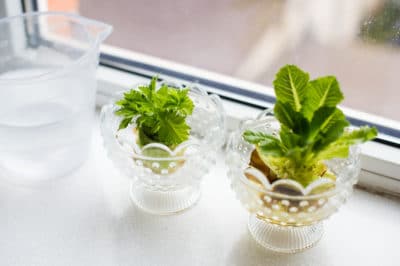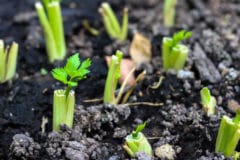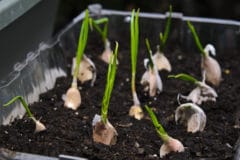What Celery Needs
A heavy feeder that originated in swamps, celery must have a constant supply of nutrients. It also needs water and will not grow well if allowed to dry out. Finally, it must have a minimum of six hours of light each day. It prefers cool temperatures and will not grow well in hot summers. You can grow it indoors to transplant size or to full maturity.
Growing for Transplants
Since celery is frost sensitive but has a very long season, many people grow it indoors initially. It’s best to start seeds about 10 to 12 weeks before the last expected spring frost. Direct seed the celery into your pots or flats, covering seeds with ¼ inch of soil. Water well but make sure soil drains readily. Make sure it has adequate light to prevent legginess.
Growing From Stalks
Celery will regrow from the stalks and can be transplanted into the garden or continued inside. Cut the stalks off about two inches above the base and place in shallow water. Change the water daily. Roots should appear within 10 days and the celery can then be planted into soil inside or outside. From that point, grow as you would transplants.
Celery Varieties
Any celery variety can be grown indoors. If you’re growing on a sunny windowsill, you might want to choose one with a shorter maturity span. Windows often have less light depending on the season. Available varieties include:
- Ventura – 80 to 100 days
- Tango Green – 85 days
- Parcel – 72 to 85 days
- Utah – 98 days
- Red Venture – 84 days
- Golden – 105 days
Celery in a Greenhouse
A greenhouse can be an ideal place to start celery when it’s too cold outdoors. You can also grow celery to harvest in a greenhouse if you’re careful not to let it get too warm. In either case, pay close attention to its nutrient needs by amending soil with well-rotted leaf mold, compost or aged manure. It will also benefit from manure or compost tea.
Celery Indoors
It’s very difficult to grow celery indoors on a windowsill it you’re trying to take it from seeds to maturity. While it needs plenty of light, well-lighted windowsills may also get too warm, especially for seedlings and small plants. Grow lights may be a better choice. Make sure the plants are close to the lights and follow the manufacturer’s instructions carefully.












